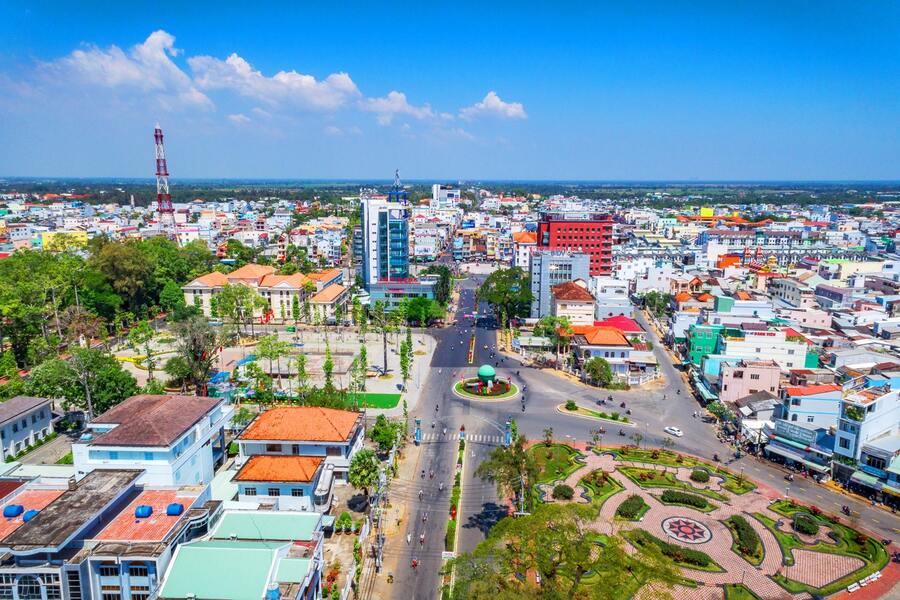Soc Trang

Soc Trang is a coastal province in the Mekong Delta, located downstream of the Hau River, where the river flows into the South China Sea at two estuaries of Dinh An and Tran De. Soc Trang is an interesting destination for tourists. You will experience many festival activities, visit famous ancient temples and enjoy many regional specialties.
As the gateway to the Mekong Delta, Soc Trang is a testament to Vietnam's diverse landscapes and vibrant communities. Contact Asia King Travel to get a fantastic adventure!
.jpg)
Afternoon time at Phu Gia Pagoda. Source: Traveloka
Read more: Southern Vietnam Tour 10 days: Highlights Exploration
Long before Soc Trang became known by its modern-day name, the province was called Nguyet Giang (meaning Moon River in English) during the Nguyen Dynasty by Emperor Minh Mang.
Before the province was named, the province was ruled by various kingdoms, including the Kingdom of Champa once dominated the Mekong Delta. For years, the Khmer Empire staked a claim over the land until the 1650s, when power was slowly transitioned to Vietnamese rulers.
.jpg)
Peaceful village scene in Dung Island (Soc Trang Province). Source: Mytour.vn
Throughout the 18th, 19th and 20th centuries, Soc Trang was affected by various events including the French Occupation of Vietnam. By 1952, 5 districts had been combined to become one jurisdiction named Soc Trang.
Unlike some areas in the Mekong Delta reminiscent of Vietnam’s French Occupation, Soc Trang is distinct from other provinces due to so much ancient Khmer culture displayed.
.jpg)
Soc Trang is a wonderful tourist destination with unique cuisine and diverse beliefs. Source: Vietnam Tourist
Like most provinces in the Mekong Delta, Soc Trang has two distinct seasons: the wet season from May to October and the dry season from November to April. You should visit Soc Trang in the dry season to avoid unexpected rains.
Dry Season (November to April): This period is characterized by lower humidity and minimal rainfall. Temperatures during the day can range from 25 to 30 degrees Celsius. The dry season is considered the more comfortable time for travel and outdoor activities.
In particular, visitors can go on the full moon day of the October lunar month to see the Ok Om Bok Festival, an attractive festival with boat races bearing the Khmer imprint.
.jpg)
The boat racing in Soc Trang during the Ok Om Bok Festival attracted many racing teams and spectators. Source: Vn Express
Soc Trang is about 231 kilometers from Ho Chi Minh City with convenient transportation, about 6 hours of travel you will arrive in Soc Trang.

View of Soc Trang City from above. Source: Laodong.vn
Pagodas are the highlight of Soc Trang Province. Most of them were built under the influence of Khmer culture. Thus, easy to recognize the unique designs of Khmer people with scrupulous attention to detail. The most famous pagoda in Soc Trang is Bat Pagoda.
This is where thousands of bats used to stay, hanging their body under the pagoda’s roofs or threes. Unfortunately, in 2010, a fire destroyed most of the furniture. Beside Bat Pagoda, Khleang Pagoda is one of the oldest pagodas in Soc Trang is known for its harmonious combination of great buildings and nature.
Clay Pagoda is famous for clay Buddhist statues and dragon sculptures. There are also 6 giant candles here, which can keep burning for 60 years. One more well-known pagoda is Chen Kieu Pagoda will impress you with China’s sophisticated design.
.jpg)
The cultural interference is perfectly demonstrated by the architecture of Kh'leang Ancient Pagoda. Source: phapluatvanhoa
Tan Long Stork Garden is known as the most ideal eco-tourism destination of Soc Trang. People come to Tan Long to watch birds and enjoy the garden, walking in the habitat of thousands of storks, bitterns and many other rare bird species. The space here is completely opposite from the busy city, giving you memorable experiences about the beautiful nature of this place.
Ho Be Beach is famous for crystal-clear natural beach and beautiful 5-kilometer long white sand beach. Besides, there is another green mangrove forest, so it will be very suitable for tourists who love to mingle with nature.
in addition to swimming, you can also walk around the beautiful forests and breathe fresh air. If you want to feel the smoothness of the sand here, try walking barefoot and feeling the cool breeze blowing.

Tan Long Stork Garden is an attractive eco-tourism destination in Soc Trang. Source: hitour.vn
Discovering the nature, culture and people from Soc Trang tourist destinations will bring you interesting surprises. There is no reason to stop your steps to such a wonderful land. Contact Asia King Travel to plan an exciting trip!
Read more: South Vietnam Tour 2 days: Cultural exploration of the Mekong Delta